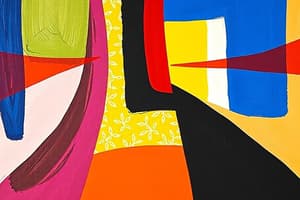Podcast
Questions and Answers
Which artist is known for the painting 'Starry Night'?
Which artist is known for the painting 'Starry Night'?
- Leonardo da Vinci
- Vincent van Gogh (correct)
- Frida Kahlo
- Pablo Picasso
What artistic movement did Pablo Picasso co-found?
What artistic movement did Pablo Picasso co-found?
- Surrealism
- Impressionism
- Futurism
- Cubism (correct)
Which of the following is a primary focus in contemporary art trends?
Which of the following is a primary focus in contemporary art trends?
- Emphasis on installation and performance art (correct)
- Exclusivity in artistic expression
- Use of traditional painting techniques
- Single artist exhibitions
What aspect is evaluated in art criticism?
What aspect is evaluated in art criticism?
Which artist is renowned for exploring identity and pain in their self-portraits?
Which artist is renowned for exploring identity and pain in their self-portraits?
What defines the visual arts?
What defines the visual arts?
Which of the following is a characteristic of the Impressionism art movement?
Which of the following is a characteristic of the Impressionism art movement?
What function of art involves reflecting and shaping cultural identity?
What function of art involves reflecting and shaping cultural identity?
In which art form would you most likely find the use of meter and rhyme?
In which art form would you most likely find the use of meter and rhyme?
Which term describes the arrangement of elements within a piece of art?
Which term describes the arrangement of elements within a piece of art?
What does the medium of an artwork refer to?
What does the medium of an artwork refer to?
Which of the following accurately describes Baroque art?
Which of the following accurately describes Baroque art?
Which characteristic is typically associated with Modernism in art?
Which characteristic is typically associated with Modernism in art?
Flashcards are hidden until you start studying
Study Notes
Overview of Art
- Definition: Art is a diverse range of human activities that involve the creation of visual, auditory, or performance artifacts that express the creator's imagination, conceptual ideas, or technical skill.
Main Forms of Art
-
Visual Arts
- Painting: Use of color, shape, and form on a surface.
- Sculpture: Three-dimensional artwork created through carving, modeling, or assembling.
- Photography: Capturing images using light-sensitive materials or digital sensors.
- Printmaking: Creating artworks by printing, typically on paper.
-
Performing Arts
- Dance: Expressive movement to rhythm or music.
- Theater: Live performance of storytelling, often involving dramatization.
- Music: Art form using sound organized in time, including vocal and instrumental performance.
- Film: A visual art form that combines moving images and sound.
-
Literary Arts
- Poetry: Expressive writing often employing meter and rhyme.
- Prose: Written or spoken language in its ordinary form.
- Drama: Texts intended for performance, typically involving conflict and characterization.
Functions of Art
- Aesthetic Value: Provides beauty and pleasure through visual, auditory, or performance elements.
- Cultural Expression: Reflects and shapes cultural identity, values, and beliefs.
- Social Commentary: Challenges societal norms and prompts discourse on political, social, or environmental issues.
- Therapeutic Influence: Used in art therapy to promote healing, self-exploration, and well-being.
Key Art Movements
- Renaissance: Emphasis on humanism, realism, and classical themes.
- Baroque: Dramatic use of light and shadow, intense emotion, and grandeur.
- Impressionism: Focus on light and momentary impressions, using loose brushwork.
- Modernism: Break from tradition, exploring new techniques and ideas.
- Postmodernism: Questions established narratives and embraces diversity and pluralism.
Important Art Concepts
- Medium: The material or technique used to create artworks (e.g., oil, acrylic, clay).
- Composition: The arrangement of elements within a piece of art.
- Perspective: Technique used to represent three-dimensional depth on a two-dimensional surface.
- Style: The distinct features and techniques characteristic of an artist or movement.
Famous Artists
- Leonardo da Vinci: Known for masterpieces like "Mona Lisa" and "The Last Supper."
- Vincent van Gogh: Celebrated for his expressive color and emotive brushwork in works like "Starry Night."
- Pablo Picasso: Co-founder of Cubism and known for "Guernica."
- Frida Kahlo: Renowned for her self-portraits and exploration of identity, pain, and femininity.
Art Criticism
- Evaluates and interprets artworks using a range of criteria, including form, content, context, and historical significance.
Contemporary Art Trends
- Emphasis on installation, performance art, and digital media.
- Increased use of social media and technology for art dissemination and engagement.
- Focus on global diversity, intersectionality, and environmental concerns in artistic practice.
Definition of Art
- Art encompasses a diverse range of human activities focused on creating artifacts that express the creator's imagination, conceptual ideas, or technical skill.
- Art can involve visual, auditory, and performance elements.
Main Forms of Art
- Visual Arts: Involve creation of visual artifacts. Types include painting, sculpture, photography, printmaking.
- Performing Arts: Involve live performance and include dance, theater, music, and film.
- Literary Arts: Involve written or spoken language, including poetry, prose, and drama.
Functions of Art
- Aesthetic Value: Provides beauty and pleasure to the viewer or audience.
- Cultural Expression: Reflects and shapes the culture's identity and values.
- Social Commentary: Challenges societal norms and sparks conversation about political, social and environmental issues.
- Therapeutic Influence: Used in art therapy to promote healing and self-exploration.
Key Art Movements
- Renaissance: Humanism, realism, and classical themes were central.
- Baroque: Dramatic use of light and shadow, intense emotions and grandeur.
- Impressionism: Focused on capturing light and momentary impressions using loose brushwork.
- Modernism: Broke from tradition, exploring new techniques and ideas.
- Postmodernism: Questioned established narratives and embraced diversity and pluralism.
Important Art Concepts
- Medium: The material or technique used to create art; examples are oil, acrylic, or clay.
- Composition: The arrangement of elements within a piece of art.
- Perspective: Technique used to represent three-dimensional depth on a two-dimensional surface.
- Style: The distinct features and techniques characteristic of an artist or art movement.
Famous Artists
- Leonardo da Vinci: Known for masterpieces like "Mona Lisa" and "The Last Supper."
- Vincent van Gogh: Known for his expressive color and emotive brushwork in works like "Starry Night."
- Pablo Picasso: A co-founder of Cubism, known for "Guernica."
- Frida Kahlo: Renowned for her self-portraits that explored themes of identity, pain, and femininity.
Art Criticism
- It involves evaluating and interpreting artworks using criteria like form, content, context, and historical significance.
Contemporary Art Trends
- Use of installation, performance art, and digital media.
- Increased use of social media and technology to share and engage with art.
- A focus on global diversity, intersectionality, and environmental concerns in art.
Studying That Suits You
Use AI to generate personalized quizzes and flashcards to suit your learning preferences.




